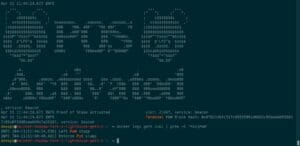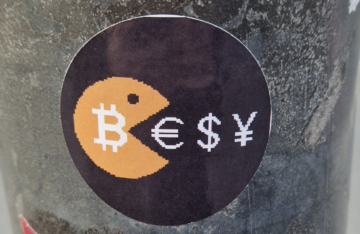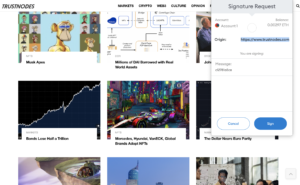The barely month old ethereum second layer zkSync has attracted about $250 million in crypto deposits to their new network.
This is one of the first zk-rollup EVM, handling defi, NFTs, and much of what the ethereum blockchain can handle.
Though at lower fees. So we gave it a testrun, starting with bridging a small amount from the mainnet to zkSync.
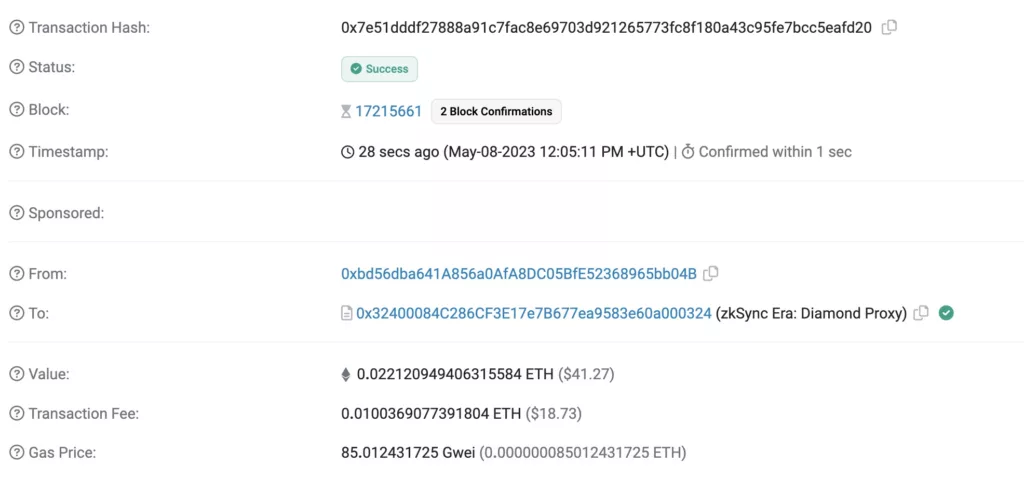
From a User Interface (UI) point of view bridging was a very simple matter of just entering how much we want to transfer, giving us the backend showing we sent it to the Dimond Proxy and paid on-chain $18 for it, or about 50% of what we are transferring.
So now that we are on zkSync, we thought of buying the trustnodes.zkSync domain at ZNS because we can and because the lifetime cost is less than $5.

We don’t have to find the zkSync network, the dapp enters all the necessary details instead and asks us to approve, which we did.
It is then only a matter of clicking Register to actually buy the domain and own it forever more apparently, giving us the backend.
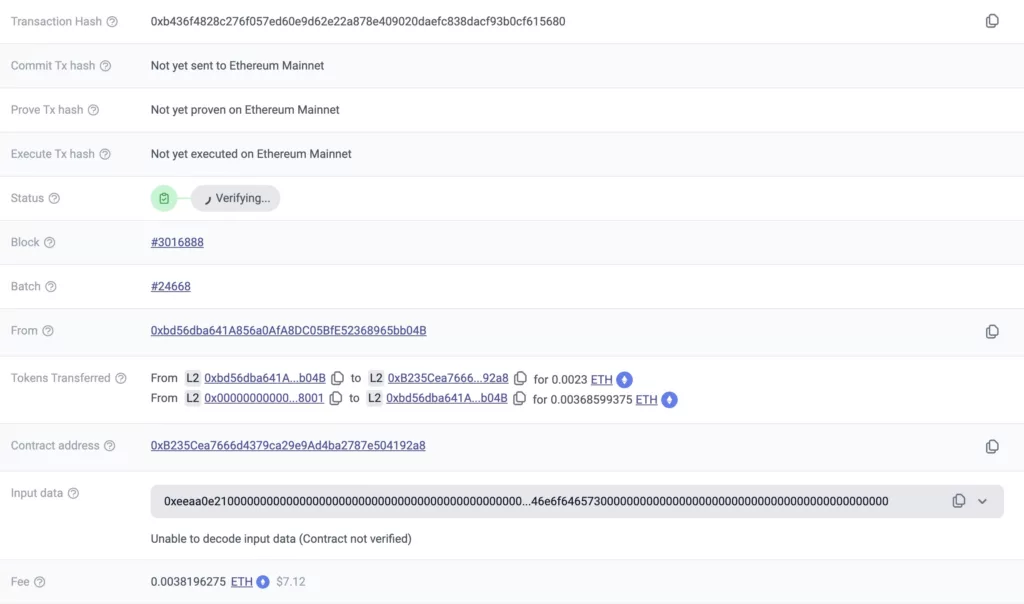
The fee is now seven dollars and to get the ZNS domain there were internally two transfers, both on the second layer (L2).
From a usability perspective, this was very smooth. Just click and go, so we tried another dapp called Mute.
Both for Mute and ZNS we randomly came across them by scrolling through the zkSync ecosystem, with ZNS being one of the few familiar dapp as it’s obviously a play on ENS.
Mute instead is ‘bonds,’ which we initially thought were government bonds, but quickly realized is actually chicken bonds.
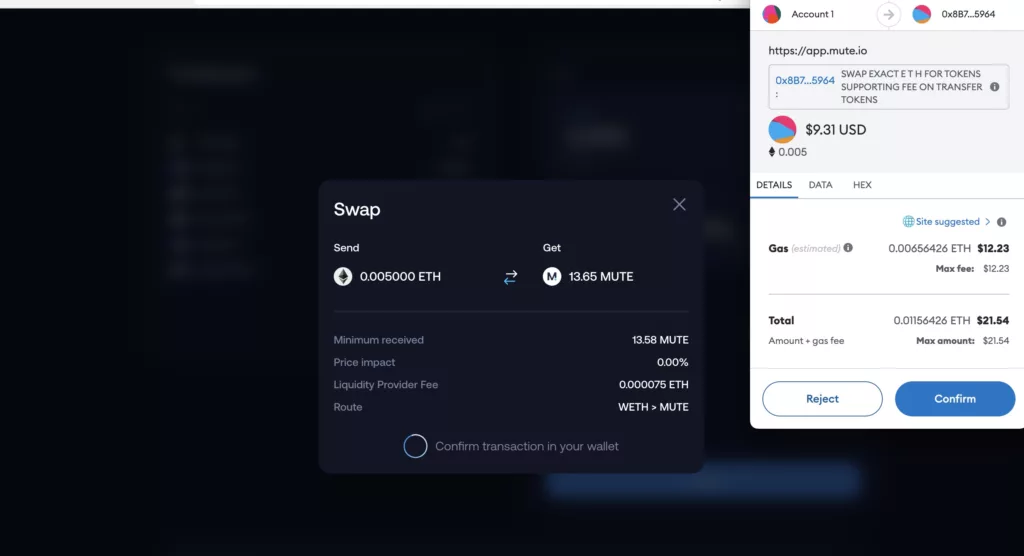
An onchain swap currently costs $30, but on zkSync the estimated fee is $12. That’s 3x lower, though not quite cents as some might have hoped.
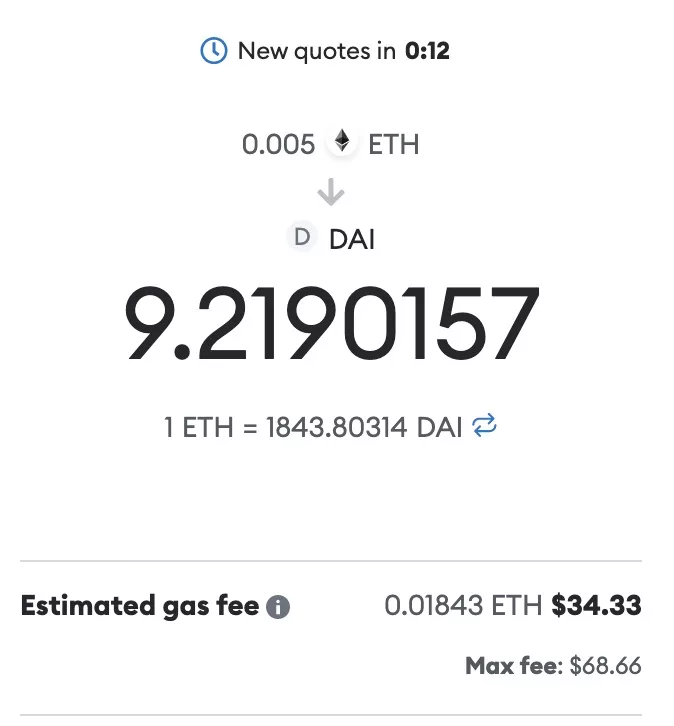
Just for reference we performed the same transaction on MetaMask, and while on Mute we probably would have gone ahead if we had actually wanted to invest, onchain we might have thought twice about it and might have even be put off.
So the difference can matter. In this case we didn’t go through with either, save for the domain transaction, because considering the small deposit in zkSync, leaving some for the future is a less risky investment than buying an unknown token.
That might just mean we missed out on a potential future airdrop, but we came to test and get a feel and we’ve gotten that.
Smooth, But Like a Ferrari
It’s a bit interesting how quick it all felt on zkSync. Starting with the bridge, there’s a warning on it the deposit might take five minutes. It actually was instant.
We didn’t measure it, maybe there was a one second delay, but no more than that because as soon as we clicked confirm on MetaMask, the bridge said we had deposited and it was all good to go.
Likewise for ZNS. After clicking on Register, we expected the usual suspense followed by the examination of the zkSync explorer, but instead it immediately said congrats, showed the domain in some sort of NFT form, and we were done.
That smooth experience is what we expect from ethereum nowadays. It used to be different, and in bitcoin it still is, but ethereum is not quite instant, it operates with a 12 second delay at best.
Usually that doesn’t matter and has its own exciting part as you scrutinize the transaction while waiting for it to complete, but this brief experience on zkSync nonetheless makes it feel even better than Web2.0.
And it is, because we already have MetaMask and funds in it. No need to remember passwords, click confirm on email, get some text message – hopefully not on an old number you don’t have anymore and now you have to reset your mother’s middlename.
It’s strange actually, come to think of it, how we’ve sleepwalked into the buying experience becoming a bit of a nervous affair and sometime a very long affair.
While here, no one to call to confirm it is us as banks sometime require – albeit rarely. No speed thinking for a few seconds regarding where the SMS 2FA code will go, and no jumping through hoops, nor needing to confirm anything except to click Confirm.
And just like that we’ve got the power to do with our money what we please in a pseudo-anonymous way with the highest level of convenience that can be achieved online.
So 10 out of 10 there, but the smooth ferarri, just like the real one, is a bit expensive.
For second layers nowadays we’ve been used to expecting fees in cents, but that was always with the understanding they weren’t quite decentralized.
Arbitrum and Optimism, beyond the centralized sequencer, also make tradeoffs in regards to security as they keep accounts off-chain.
zkSync batches transactions for which it keeps accounts off-chain, but submits a proof to the ethereum network for each batch.
Optimism is called that because it is optimistic validation, as in you shouldn’t expect cheating because some people might be caught.
In zkSync, and in theory as we haven’t looked at the code in detail, you can’t cheat, optimistically or pessimistically, and the on-chain proof proves as much.
That the fees are not so low therefore gives a hint on the surface that it hasn’t made very significant tradeoffs.
Still, a $12 fee on an L2 isn’t quite what we expected. And yet, if this is basically eth, a 3x reduction is something.
Except it isn’t quite eth. zkSync is based on zk-snarks, which require a ‘trusted’ magic ceremony.
Ethereum has been going through a similar ceremony too. It is the first one in which we have participated, making the ‘magic’ real, while adding nuances to just how trusted this setup is.
For ethereum, tens of thousands haave also participated, and in any event this applies only to the danksharding new data addition for second layers, not eth itself.
The 3x savings therefore, with some edge tradeoffs, is reality hitting expectations for some. But this is a one month old network. The batches can be increased in size presumably, which would lower transactions, and there may be other efficiency gains.
The ethereum network in addition has a capacity limit, which means fees at the end tail can be exponential. For zkSync, its amount of fees depends in part on on-chain fees, but otherwise it doesn’t necessarily have a capacity limit until maybe 10x ethereum’s current capacity.
If that is the case, the $12 fee is for all say 10 million transactions, while for eth it is for one million transactions.
That difference matters because looked holistically the equivalent fee would be $1.2 in eth because we have 10x capacity.
That is sophistry where our own wallet is concerned, where $12 was actually paid, but the nuances matter as network security and decentralization are not cheap as chips.
Nor however are they as expensive as Ferraris. A balance has to be found, and whether part of that is from our own expectations remains to be seen from other second layers as well as from how zkSync develops.
But the good news is that what was talks, promises, and so on, is now something we can see and get actual results.
Based on that a 3x savings if, as it implies, comes with it being almost as good as eth, isn’t too bad if that’s just how it is as that might just be the hard reality of scaling.
But 100 batched transactions shouldn’t cost as much as 35 on-chain transactions if they need only one on-chain proof transaction.
That they do suggests the batch is not 100, but maybe 20, and in that case that it costs as much can fundamentally be good news because it shows it all works and the fee problem is just a matter of increasing the batch size.
In other words, unlike the base blockchain which has potentially even unsolvable tradeoffs in regards to capacity, here it may just be more that it is so new, they’re starting small.
In that case it might be interesting as second layers can potentially work if the tradeoffs are so minimal that the fees have to be high.
Our overall rating therefore is 3.5 out of 5. It’s the first such rating for a second layer, so we don’t know how it compares yet, and it is limited to as far as end users are concerned, rather than backend code weighing.
The speed is awesome for end users, but the fees are high and there’s no escaping that. They may go lower however and from a wholistic perspective, this first test run of a zk EVM is interesting because the fees are a revelation if they do suggest what is implied, that this is all proper.
That would make it a first introduction to the very hard work of dialup plumbing, where there’s no magic trick but somewhat incremental improvements that hopefully will in the end amount to the arrival of broadband.
- SEO Powered Content & PR Distribution. Get Amplified Today.
- PlatoAiStream. Web3 Data Intelligence. Knowledge Amplified. Access Here.
- Minting the Future w Adryenn Ashley. Access Here.
- Buy and Sell Shares in PRE-IPO Companies with PREIPO®. Access Here.
- Source: https://www.trustnodes.com/2023/05/08/zksync-crosses-quarter-of-a-billion
- :has
- :is
- :not
- :where
- $10 million
- 10
- 100
- 12
- 20
- 2023
- 2FA
- a
- About
- about IT
- Accounts
- achieved
- across
- actually
- adding
- addition
- After
- ahead
- airdrop
- All
- already
- also
- always
- amount
- an
- and
- Another
- any
- anymore
- anything
- approve
- ARE
- arrival
- AS
- At
- attracted
- Backend
- Bad
- Balance
- Banks
- base
- based
- Basically
- BE
- because
- becoming
- been
- being
- BEST
- Better
- Beyond
- Bit
- Bitcoin
- blockchain
- Bonds
- both
- BRIDGE
- bridging
- broadband
- but
- buy
- Buying
- by
- call
- called
- came
- CAN
- Capacity
- case
- caught
- centralized
- cheap
- cheating
- Chips
- click
- code
- come
- comes
- complete
- concerned
- Confirm
- considering
- convenience
- Cost
- Costs
- crypto
- Current
- Currently
- dapp
- data
- Decentralization
- decentralized
- DeFi
- delay
- depends
- deposit
- deposited
- deposits
- detail
- details
- develops
- DID
- difference
- different
- do
- Doesn’t
- dollars
- domain
- done
- Dont
- each
- Edge
- efficiency
- either
- end
- ENS
- Enters
- Equivalent
- estimated
- ETH
- ethereum
- Ethereum blockchain
- ethereum network
- Ethereum's
- Even
- Event
- EVM
- Except
- exciting
- expect
- expectations
- expected
- expecting
- expensive
- experience
- explorer
- exponential
- familiar
- far
- fee
- feel
- Fees
- few
- Find
- First
- followed
- For
- forever
- form
- found
- from
- fundamentally
- funds
- future
- Gains
- gave
- get
- gives
- Giving
- Go
- going
- good
- Government
- government bonds
- had
- handle
- Handling
- Hard
- hard work
- Have
- here
- High
- highest
- hitting
- Hopefully
- How
- However
- HTTPS
- if
- immediately
- implied
- improvements
- in
- increased
- increasing
- initially
- instant
- instead
- interesting
- Interface
- internally
- into
- Introduction
- Invest
- investment
- IT
- ITS
- itself
- just
- Keep
- Know
- l2
- layer
- layers
- leaving
- less
- Level
- lifetime
- like
- LIMIT
- Limited
- Long
- looked
- Low
- made
- magic
- mainnet
- make
- MAKES
- Making
- Matter
- Matters
- max-width
- May..
- mean
- means
- measure
- message
- MetaMask
- might
- million
- minimal
- minutes
- money
- Month
- more
- much
- necessarily
- necessary
- Need
- needing
- network
- Network Security
- New
- news
- NFT
- NFTs
- no
- now
- number
- of
- off
- Old
- on
- On-Chain
- Onchain
- ONE
- online
- only
- operates
- Optimism
- Optimistic
- or
- Other
- otherwise
- our
- out
- overall
- own
- own wallet
- paid
- part
- participated
- Passwords
- People
- perspective
- plato
- Plato Data Intelligence
- PlatoData
- Play
- please
- Plumbing
- Point
- Point of View
- potential
- potentially
- power
- probably
- Problem
- promises
- proof
- proper
- proves
- proxy
- put
- Quick
- quickly
- rather
- rating
- real
- Reality
- realized
- reduction
- regarding
- regards
- register
- remains
- remember
- require
- Results
- Risky
- Run
- Said
- same
- Save
- Savings
- say
- scaling
- scrolling
- Second
- Second Layers
- seconds
- security
- see
- seen
- setup
- seven
- Shows
- significant
- similar
- Simple
- Size
- small
- SMS
- So
- some
- something
- somewhat
- Soon
- speed
- Starting
- Still
- such
- suggest
- Suggests
- Surface
- swap
- Take
- Talks
- test
- Test run
- than
- that
- The
- The Future
- their
- Them
- then
- There.
- therefore
- they
- Think
- Thinking
- this
- though?
- thought
- Through
- to
- token
- too
- transaction
- Transactions
- transfer
- Transferring
- transfers
- tried
- trusted
- Trustnodes
- Twice
- two
- ui
- understanding
- unknown
- unlike
- until
- us
- usability
- used
- User
- User Interface
- users
- validation
- very
- View
- Waiting
- Wallet
- want
- wanted
- warning
- was
- Way..
- we
- Web2
- webp
- weighing
- WELL
- were
- What
- What is
- whether
- which
- while
- will
- with
- words
- Work
- works
- would
- yet
- you
- Your
- zephyrnet
- ZK
- zk-rollup
- zk-SNARKS
- zkSync









